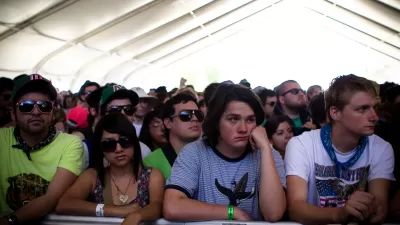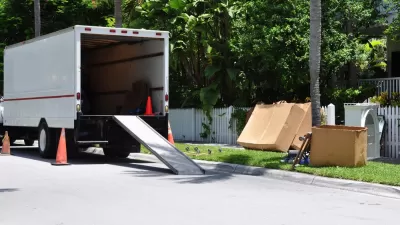Recent studies have found that trends born of the Great Recession have left Millennials stuck in place. A recent article places the current milieu in context by comparing historic rates of mobility.

Stephen Mihm launches his investigation of American mobility by describing contemporary young Americans as anchored in place: "by one estimate, only 20.1 percent of millennials moved in the past year." Moreover, "[when] you look at 'long-distance moves' -– between counties or states -– it is only 7 percent, close to a historical low." And finally, "a whopping 36 [of Millennials] are now living with their parents."
Then, to compare and contrast the current mobility of contemporary young Americans to past generations, Mihm examines historic anecdotes and data, starting with Tocqueville through the middle of the 19th century and through the post-war realities of the mid-20th century.
According to Mihm, the country's tradition of mobility is at odds with the current stagnation of the Millennial generation. "But why are millennials, who are less likely to own a home, so thoroughly stuck in place?" he asks.
Mihm doesn't answer his question, but he does pose another thought-provoking jab: "[if] an earlier generation of Americans blessed with fewer resources and advantages could pull up roots and move to new towns and cities, sight unseen, it seems strange that millennials can’t do the same."
FULL STORY: Millennials Need to Leave the Parent Trap

Study: Maui’s Plan to Convert Vacation Rentals to Long-Term Housing Could Cause Nearly $1 Billion Economic Loss
The plan would reduce visitor accommodation by 25,% resulting in 1,900 jobs lost.

North Texas Transit Leaders Tout Benefits of TOD for Growing Region
At a summit focused on transit-oriented development, policymakers discussed how North Texas’ expanded light rail system can serve as a tool for economic growth.

Using Old Oil and Gas Wells for Green Energy Storage
Penn State researchers have found that repurposing abandoned oil and gas wells for geothermal-assisted compressed-air energy storage can boost efficiency, reduce environmental risks, and support clean energy and job transitions.

A Bronx Community Fights to Have its Voice Heard
After organizing and giving input for decades, the community around the Kingsbridge Armory might actually see it redeveloped — and they want to continue to have a say in how it goes.

Houston Mayor Promises Dedicated Austin Street Bike Lane After Public Backlash
Although the one-way bike lane won’t be protected by physical barriers, the proposal is an improvement over the mayor’s initial plan to only include sharrows on the Austin Street project.

How Atlanta Built 7,000 Housing Units in 3 Years
The city’s comprehensive, neighborhood-focused housing strategy focuses on identifying properties and land that can be repurposed for housing and encouraging development in underserved neighborhoods.
Urban Design for Planners 1: Software Tools
This six-course series explores essential urban design concepts using open source software and equips planners with the tools they need to participate fully in the urban design process.
Planning for Universal Design
Learn the tools for implementing Universal Design in planning regulations.
Borough of Carlisle
Caltrans
Heyer Gruel & Associates PA
Institute for Housing and Urban Development Studies (IHS)
City of Grandview
Harvard GSD Executive Education
Toledo-Lucas County Plan Commissions
Salt Lake City
NYU Wagner Graduate School of Public Service





























